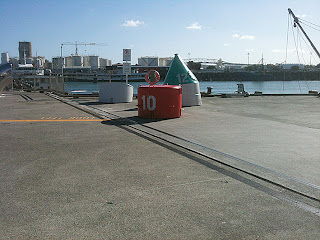I said in my previous post, “The area was called North Wharf (which made me wonder where “South Wharf” is—there isn’t one, by the way), and was a barren, empty windswept theme park interpretation of a waterfront—but I’ll elaborate on that in another post.” This is that post.
The photo above is of North Wharf, looking toward the “tank farm”. The tank farm is slowly being removed and the area will be redeveloped. This particular area was redone in time for the Rugby World Cup.
I found it incredibly sterile and fake, a theme park version of what a working waterfront might look like. The low buildings on the left side of the photo were all built to resemble waterfront warehouses, complete with fake distressing to make them seem more “real”. They were all were restaurant/café/bar facilities, and basically barns: Cavernous, cold—and empty. They all had very few people in them (sometimes staff outnumbered customers) at noon. The photos with this post were all taken at about 12:45pm—the height of the lunch rush—and there was hardly anyone around.
This area may become busier as construction of office buildings are completed. But for the area to be a real, vibrant area of the city, they really need to tone down the phony ship-chic theme park decoration. The next photo below, taken from the same spot as above but moved slightly to the right, shows some more of the phony props (the Auckland Harbour Bridge is in the background).
 On the other hand, there are ways to pay homage to the area’s heritage without degenerating into kitsch. For example, the info centre (the photo at the bottom of the post) is made from used shipping containers. The back of the one at ground level on the left side of the photo even contains public toilets.
On the other hand, there are ways to pay homage to the area’s heritage without degenerating into kitsch. For example, the info centre (the photo at the bottom of the post) is made from used shipping containers. The back of the one at ground level on the left side of the photo even contains public toilets.There’s also integration of newer technologies. Stops around the wharf have signs with QR codes so visitors with smartphones can look up the area’s history. I didn’t try this—I was in too bad a mood because of the Roadshow at this point, but when I go back in warmer weather, I will.
These two things—integrating newer technology and sensible references to the area’s past—point to the way forward. The area is basically a construction zone, transitioning from its tourist-centred kitsch to its future as a vibrant part of the city. Much as this area left me cold, literally and figuratively, I’m very interested to see how it evolves.
It could be really good.



No comments:
Post a Comment